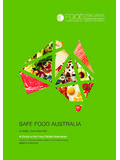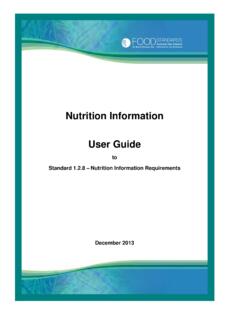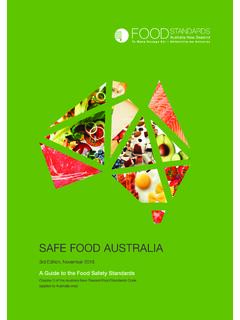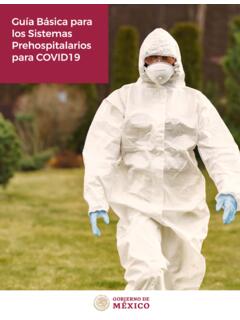Transcription of Salmonella (non-typhoidal) - Food Standards
1 1 Salmonella (non-typhoidal) Salmonella spp. are bacteria that cause salmonellosis, a common form of foodborne illness in humans. Outcomes from exposure to Salmonella spp. can range from mild symptoms to severe disease and can be fatal. Salmonella spp. are carried by a range of domestic and wild animals and birds and have been widely isolated from the environment. Description of the organism Salmonella spp. are Gram-negative, non-spore forming rod-shaped bacteria and are members of the family Enterobacteriaceae (Jay et al. 2003). The genus Salmonella is divided into two species: S.
2 Enterica (comprising six subspecies) and S. bongori. Over 99% of human Salmonella spp. infections are caused by S. enterica subsp. enterica (Bell and Kyriakides 2002; Crum-Cianflone 2008). Strains of Salmonella can be characterised serologically (into serovars) based on the presence and/or absence of O (somatic) and H (flagella) antigens. Phage typing is used to subtype Salmonella serovars. The phage type is determined by the sensitivity of the bacterial cells to the lytic activity of selected bacteriophages (Bell and Kyriakides 2002; Jay et al. 2003). The formal names used to describe types of Salmonella are rather cumbersome, for example S.
3 Enterica subsp. enterica serovar Typhimurium. For practical reasons, the abbreviated versions of these names using just the serovar are commonly used, such as S. Typhimurium (Crum-Cianflone 2008). Some Salmonella serovars are host-adapted to individual animal species and may differ vastly in the severity of the disease they cause; others such as S. Typhimurium have a broad host range, with an ability to infect a wide range of animals, including humans (Jay et al. 2003; Wallis 2006). S. Typhi and S. Paratyphi are specifically associated with infections in humans, leading to severe disease called enteric fever.
4 S. Typhi and S. Paratyphi produce clinical syndromes referred to as typhoid and paratyphoid fever, respectively. Enteric fever is rare in developed countries, with the majority of cases associated with overseas travel (Darby and Sheorey 2008). In Australia of notified cases of typhoid fever were likely to have been acquired overseas in 2010 (OzFoodNet 2012). Growth and survival characteristics Salmonella spp. have relatively simple nutritional requirements and can survive for long periods of time in foods and other substrates. The growth and survival of Salmonella spp. is influenced by a number of factors such as temperature, pH, water activity and the presence of preservatives (refer to Table 1).
5 2 The temperature range for growth of Salmonella spp. is C, with the optimal temperature being 35 43 C (ICMSF 1996). Although freezing can be detrimental to Salmonella spp. survival, it does not guarantee destruction of the organism. There is an initial rapid decrease in the number of viable organisms at temperatures close to the freezing point as a result of the freezing damage. However, at lower temperatures Salmonella spp. have the ability to survive long term frozen storage (Jay et al. 2003). Strawn and Dayluk (2010) showed that Salmonella was able to survive on frozen mangoes and papayas stored at -20 C for at least 180 days.
6 Heat resistance of Salmonella spp. in food is dependent on the composition, pH and water activity of the food. The heat resistance of Salmonella spp. increases as the water activity of the food decreases. Foods which are high in fat and low in moisture, such as chocolate and peanut butter, may have a protective effect against heat. In low pH conditions the heat resistance of Salmonella spp. is reduced (Jay et al. 2003; Shachar and Yaron 2006; Podolak et al. 2010). Salmonella spp. will grow in a broad pH range of , with an optimum pH range for growth of 7 (ICMSF 1996). The minimum pH at which Salmonella spp.
7 Can grow is dependent on temperature, presence of salt and nitrite and the type of acid present. Volatile fatty acids are more bactericidal than organic acids such as lactic, citric and acetic acid. Outside of the pH range for growth, cells may become inactivated, although this is not immediate and cells have been shown to survive for long periods in acidic products (Bell and Kyriakides 2002; Jay et al. 2003). Water activity (aw) has a significant effect on the growth of Salmonella spp., with the optimum aw being and the lower limit for growth being Salmonella spp. can survive for months or even years in foods with a low aw (such as black pepper, chocolate, peanut butter and gelatine) (ICMSF 1996; Podolak et al.)
8 2010). Salmonella spp. are similar to other Gram negative bacteria in regard to susceptibility to preservatives commonly used in foods. Growth of Salmonella spp. can be inhibited by benzoic acid, sorbic acid or propionic acid. The inhibition of Salmonella spp. is enhanced by the use of a combination of several preservative factors, such as the use of a preservative in conjunction with reduction in pH and temperature (ICMSF 1996; Ha et al. 2004; Banerjee and Sarkar 2004). Salmonella spp. are classed as facultative anaerobic organisms as they do not require oxygen for growth (Jay et al.
9 2003). Table 1: Limits for growth of Salmonella spp. when other conditions are near optimum (ICMSF 1996; Podolak et al. 2010) Minimum Optimum Maximum Temperature ( C) 35 43 pH 7 Water activity > 3 Symptoms of disease Outcomes of exposure to non-typhoidal Salmonella spp. can range from having no effect, to colonisation of the gastrointestinal tract without symptoms of illness (asymptomatic infection), or colonisation with the typical symptoms of acute gastroenteritis.
10 Gastroenteritis symptoms are generally mild and may include abdominal cramps, nausea, diarrhoea, mild fever, vomiting, dehydration, headache and/or prostration. The incubation period is 8 72 hours (usually 24 48 hours) and symptoms last for 2 7 days (WHO/FAO 2002; Darby and Sheorey 2008). Severe disease such as septicaemia sometimes develops, predominantly in immunocompromised individuals. This occurs when Salmonella spp. enter the bloodstream, leading to symptoms such as high fever, lethargy, abdominal and chest pain, chills and anorexia; and can be fatal. A small number of individuals develop a chronic condition or sequelae such as arthritis, appendicitis, meningitis or pneumonia as a consequence of infection (Hohmann 2001; WHO/FAO 2002; FDA 2012).

















